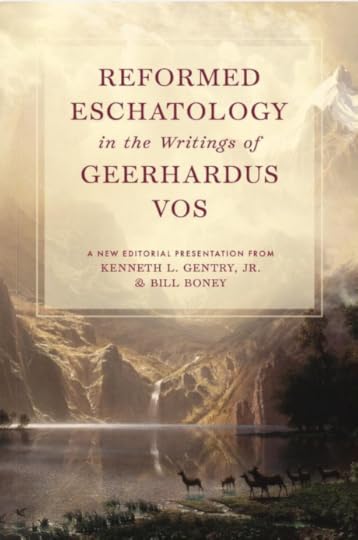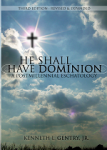HYPERPRETERISM VS. THE GOSPEL (1)
PMW 2025-058 by Kenneth L. Gentry, Jr.
Introduction
Hyper-preterism in all of its various, warring branches is heretical at its very core. By “hyper-preterism” I am not limiting the concept to what is known as “full preterism” or “consistent preterism.” such a definition practice is a common maneuver by hyper-preterists who are not absolutely and fully preterist in every single detail. By doing this, they can claim: “I am not a FULL preterist,” thinking that this declaration allows them to avoid the charge of being “hyper.” They are hoping this will allow them to fly under the radar and not be charged with eroding the foundations of the Christian faith.
Rather, I am more narrowly applying this distinctive term to the core issues that breach orthodoxy, whether each-and-every nuance of some full or consistent preterist is adopted. The label “hyper-preterist,” therefore, applies to any system of preterism that denies three key evangelical (orthodox) doctrines known as “The Three R’s of Eschatology.” Those doctrines that are denied by “hyper-preterists” are:
1. The Return of Christ (at the end of history in bodily, physical form).
2. The Resurrection of the dead (at the end of history in bodily, physical form— despite how “difficult” this might be for God.
3. The Renewal of all creation (after the resurrection as the new creation is established in its final, physical, eternal form).
In this short study series I will be speaking against hyper-preterism by showing that it ultimately denies the very gospel of Jesus Christ. I will do this by focusing on the doctrine of the physical resurrection of the body at the end of history, which is a key component of historic orthodoxy and is directly related to Paul’s definition of the gospel (I will get to this point eventually in this series).
More particularly, however, I will be highlighting the resurrection as it appears in 1 Corinthians 15. This portion of Scripture is the pre-eminent chapter for declaring and explaining the Christian’s future, corporate, consummate, physical resurrection. But as we begin I would note that we cannot selectively pluck its verses out of their context, as I showed in my preceding post on the topic (PMW 2025-057: “Flesh and Blood Cannot Inherit the Kingdom of God?”). I would highlight two key reasons for this warning.
First, the issue of immediate context. In my previous posting I noted the importance of recognizing Paul’s carefully-designed rhetorical structure that governs a particular unit of thought within this chapter. And that structural unit trips up neo-Gnostic hyper-preterists. [1] I argued that we must recognize the immediate contextual setting of 1 Corinthians 15:50. Since the recent arising of hyper-preterism, that verse has too often been used alone, divorced from its context. It has become a bumper sticker for hyper-preterists. But it is not a stand-alone verse. It actually opens a distinct, four-verse, inter-connected unit of thought (vv. 50–53) that warns that “flesh and blood cannot inherit the kingdom of God” (v. 50).
Reformed Eschatology in the Writings of Geerhardus Vos
Ed. by Ken Gentry and Bill Boney
This is a collection of several key eschatological studies by the renowned Reformed theologian Geehardus Vos. We have modernized Vos’ grammar and syntax and updated his layout style according to modern publishing conventions (shorter sentences and paragraphs). We did this without changing any of Vos’ arguments.
For more information on this new Vos work or to order it, see:
https://www.kennethgentry.com/reformed-eschatology-in-the-writings-of-geerhardus-vos/
We saw that verse 50 has been misinterpreted by ancient Gnostics (“full” Gnostics, you might say!), recent liberals, and contemporary hyper-preterists (neo-Gnostics). This doctrinal stumbling is caused by not recognizing that Paul engages in a carefully-structured argument here. His rhetorical argument employs a synonymous parallelism that unfolds in a concentric movement driving home a particular point (see that article). And that preceding article was just one short discussion of one small unit in this lengthy chapter, a chapter whose sheer size and complexity requires much more discussion.
Second, the issue of the whole-book context. So now I would warn the would-be interpreter not to overlook the much larger context of 1 Corinthians 15 as a whole. That is, we should understand 1 Corinthians 15:50 in its place within the flow of the entire epistle. This requires that we understand Paul’s special concern in his letter to the Corinthians. That concern, as we shall see, prepares us for the importance of properly understanding the believer’s bodily resurrection.
In other words, chapter 15 is not some disconnected aside in this lengthy letter (per some liberal scholars). Paul is not randomly throwing it in as just one more issue as he prepares to close his epistle in 1 Corinthians 16:1–24. He is not saying, “Oh, yeah! Before we close let’s focus for a moment on just one more thing. I have another 10 inches of scroll left.” In fact, he has purposefully placed his resurrection material of chapter 15 at the end of his epistle as its very goal and high point. And understanding this lends even greater significance to the resurrection of our material bodies. In this current series I will show how this is the case. So, let’s begin by considering:
Paul’s Introduction
After his formal introduction to his epistle in 1 Corinthians 1:1–9, Paul opens the main body of his letter at verse 10. Here we see a statement of his key concern regarding the church at Corinth, which he hopes to overcome:
“Now I exhort you, brethren, by the name of our Lord Jesus Christ, that you all agree and that there be no divisions [schismata] among you, but that you be made complete in the same mind and in the same judgment.”
Greatness of the Great Commission (by Ken Gentry)
An insightful analysis of the full implications of the great commission as given in Matthew 28:18-20. Impacts postmillennialism as well as the whole Christian worldview.
See more study materials at: www.KennethGentry.com
Verse 10 contains his first parakaleo (exhortation) clause in the letter (see the Greek also at 4:16; 16:12, 15). And this appears surprisingly early in his letter: immediately after completing the letter’s formal introduction (1:1–9). Contrast this to Romans which places its first exhortation clause at 12:1! This maneuver emphasizes Paul’s deep concern as he deals with the Corinthians. Although he highlights numerous concerns regarding this troubled church (relational, moral, ecclesiastical, sacramental, etc.), here we will see that his core concern, his opening concern is: doctrinal.
Here in v. 10 Paul exhorts the Corinthians to be unified. But unified in what? As we will see, he is urging unity in doctrine. Note that he expressly urges them to “agree,” which in the Greek literally means: “that you all say the same thing” (hina to auto legete pantes), i.e., that you speak (affirm, teach, proclaim) the same truths. This exhortation is clearly doctrinal for it is designed so that they be “made complete in the same mind and in the same judgment.”
Consequently, Paul explains that at the root of their “divisions” [schismata] are doctrinal concerns. He exhorts them that they must be of “the same mind,” i.e., “united in your beliefs” (NJB). And of “the same judgment [gnome],” i.e., the same “viewpoint or way of thinking” (BAGD), “thought” (NIV).

He Shall Have Dominion
(paperback by Kenneth Gentry)
A classic, thorough explanation and defense of postmillennialism (600+ pages). Complete with several chapters answering specific objections.
See more study materials at: www.KennethGentry.com
Key details
But now we must note that even at the conclusion of his introduction to this lengthy epistle in verses 7–9, he already anticipates the conclusion of his theological argument as a whole, which is found in chapter 15. Thus, his introduction points to his conclusion. What do I mean? How is this so?
Here in 1:7–9, Paul encourages the Corinthians to remember that they are to be “awaiting eagerly the revelation of our Lord Jesus Christ” (1:7), i.e., his second coming. And they must understand that the Lord’s desire is to “confirm [them] to the end” so that they will be “blameless in the day of our Lord Jesus Christ” (1:8). That is, they are to strive to be blameless until the end, until the second coming, the ultimate day of the Lord long anticipated even in the Old Testament.
So then, in closing out his opening comments, Paul is already anticipating his conclusion to the epistle as a whole. He saves for the last point of the main body of his letter, his doctrinal concern regarding the end (e.g., 15:23–26, 52), which, as he will show, involves the resurrection (1 Cor. 15 en toto). Thus, he will emphasize the significance of the eschatological end not only by the chapter’s size (58 verses, the largest in the letter) but its placement (the climax to his letter).
So then, in chapter 15 he reaches his climactic high point: he will carefully (in his highly structured presentation) and strongly (rebuking and challenging, vv. 32–34, 36) remind them of the ultimate consummation of God’s kingdom of salvation. And as we shall see, this is all rooted in the very gospel itself (15:1). He is doing this so that, rather than dividing themselves and fighting one another, they will stand together steadfast in the Lord “knowing [their] toil is not in vain in the Lord” (15:58).
We will be seeing in this series that there is more to what is going on in the whole letter of 1 Corinthians than meets the eye of the casual reader. My point will become much clearer when we have all postings on the topic completed. Stay tuned. As General MacArthur said (in the original English): “I will be back!” Or was that Arnold Schwarzenegger? Who cares who said it? I will be back.
 The Beast of Revelation (246pp); Before Jerusalem Fell: Dating the Book of Revelation (409pp); Navigating the Book of Revelation: Special Studies on Important Issues (211pp).
The Beast of Revelation (246pp); Before Jerusalem Fell: Dating the Book of Revelation (409pp); Navigating the Book of Revelation: Special Studies on Important Issues (211pp).
In the Logos edition, these volumes by Ken Gentry are enhanced by amazing functionality. Important terms link to dictionaries, encyclopedias, and a wealth of other resources in your digital library. Perform powerful searches to find exactly what you’re looking for. Take the discussion with you using tablet and mobile apps. With Logos Bible Software, the most efficient and comprehensive research tools are in one place, so you get the most out of your study.
For more study materials, go to: KennethGentry.com
Notes
1. Despite HP complaints, historic Christianity is not Gnostic because it recognizes an intermediate estate where the saints dwell spiritually in heaven before the second coming. The intermediate estate is temporary, much like our living on earth in mortal bodies before our death is temporary. The intermediate estate is designed to give way to the consummate order involving our physically resurrected bodies dwelling in an eternal, physical new creation.Kenneth L. Gentry Jr.'s Blog
- Kenneth L. Gentry Jr.'s profile
- 85 followers




